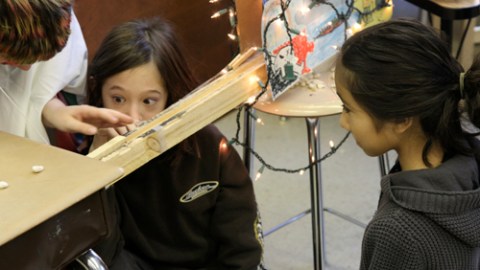Teaching Through Games at Quest2Learn

When designer Katie Salen was teaching at the University of Texas a decade ago, she came upon a novel teaching method while trying to help her students understand online interfaces and how to engage audiences: she brought in a project where students began to design and redesign games as a way to understand “What is good interactive design?” She says it was the first time that she brought games into the classroom space and put students into the role of game designers. “It was a huge moment of discovery for me because my students learned more about how to engage an audience, how to really communicate, and how to create really interesting, unusual kinds of spaces when they used game design as a starting point,” she says in her recent interview with Big Think. “Even though they weren’t designing games eventually, the process of thinking like a game designer gave them all a whole tool set that they hadn’t had previously.”
Ultimately, this discovery led Salen to found Quest2Learn, a public school in New York City that fashions its curriculum around ideas inspired by game design and digital culture. “We wanted to not only tap into the digital generation in the design of the school,” says Salen, “but also to think about, well, how can the structures of games be used to design a school in a way that was really engaging for kids, really got at content expertise, but also began to work on some of these 21st century skills that people are talking about—collaboration, working in teams, complex problem-solving, systems thinking, being able to kind of design and find resources. And so the school has really been designed as a school that uses games as a pedagogical kind of structure.”
Salen also thinks that games can help parents get closer with their children. She says that parents should try to find games that match with their child’s interests, and then participate and play alongside them. “The simplest and biggest thing a parent can do with a child is to sit down and play with them,” says Salen. “Play the game with them, talk with them about what they’re doing, prompt them, ask them questions. Kids love it when the parent asks them to show—that the kid will show the parent how to do something.”
In the past, Salen has developed interesting conceptual games like the “slow games” that she designed several years ago for Metropolis magazine that were meant to be played over 25 years—like a game where the person to send the last fax in the world would win. These days she says she’s most interested in “the social fabric component” of gaming—the way that interactions with other people within games can become increasingly interesting over time—as well as the interactions between real-world interfaces and on-screen competition. “I’m really interested in that… the data flow between something, an activity I might be doing in the real world and some implication in a virtual environment, and also potentially vice versa,” she says. “And so that’s more about notions of consequence and impact and how that might change social relations between who’s in that game and what they’re doing together.”





